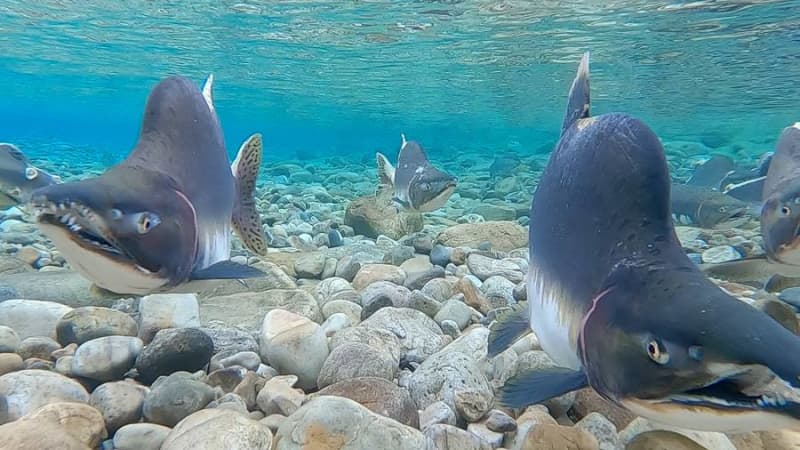
In Norway, intensive fishing of chum salmon in the sea and rivers is planned to prevent the invasive species from reproducing. The problem is how to remove chum salmon without endangering native Atlantic salmon.
There are fears of an increase in the Pacific invasive species along salmon rivers flowing into the Arctic Ocean in Norway and Finland.
According to the Norwegian Broadcasting Corporation (NRK), the Norwegian government has earmarked 25 million kroner, or €2.4 million, for the fight against humpback salmon.
The Norwegian government, fisheries authorities, coastal fishermen and many politicians are now calling for an effective sea fishery for humpback salmon and for the catch to be sold on the fish market before the species reaches the rivers to spawn, reports NRK.
The organization representing more than a hundred Norwegian salmon rivers fears that the commercial fishing of humpback salmon will make it a valuable fish and treat it like another alien species, the king crab, which today is a million-dollar business protected by fishing quotas. The fear is that the humpback salmon would deplete the rivers of natural salmon populations.
The most difficult issue in humpback salmon removal fishing is how to carry out intensive fishing without harming Atlantic salmon and other native species. Sea fishing would be done in the lower fjords of salmon rivers, such as Tenovuon.
In addition to sea fishing, in Norway, the fight against humpback salmon with barrier dams has also been tuned in the large Tenojoki.
The border river shared by Finland and Norway last experienced a mass increase in humpback salmon in the summer of 2021. The alien species increased more than the original Atlantic salmon, whose populations have collapsed and become endangered due to decades of overfishing.
Due to the threat of extinction of the natural salmon stocks in the Tenojoki watershed, the ban on catching salmon will continue next year. Parliament will decide on the matter at the beginning of the year.
With the control dam planned by Norway, the humpback salmon would be removed as an alien species and the native salmon and sea trout would be allowed to continue their migration.
– How much medication do humpback salmon have to resist? This is the place for a thorough risk assessment, so that the medicine is not worse than the disease.

According to him, it is precisely about how to distinguish humpback salmon from the natural migratory fish stocks of the area, such as salmon and sea trout, in removal fishing. The concern is that salmon stocks in poor condition may deteriorate further.
According to Erkinaro, it is not yet known whether humpback salmon can be combated at all. Also, there is still very little researched information on the effect of humpback salmon on Atlantic salmon populations.
Until now, it has been estimated that humpback salmon have not caused problems in the rivers flowing into the Barents Sea and the Viennese Sea on the Russian side, although the species has been present there for decades more abundantly than in Norway or Finland.
The latest research data on the effects of mass demonstrations in recent years in Russia are not available, because the research cooperation broke off even before the Russian attack on Ukraine.
According to Erkinaro’s information, a salmon dam across the Teno is planned in Norway, where humpback salmon would be separated and other fish would be allowed to continue their journey.
In Norway, the use of pattern recognition technology has been on display, which the Norwegians have tried with appliance dealers with small salmons.
– I don’t know how advanced such plans are on a practical level. Now it’s almost Christmas and all of this should be in operation next summer, says Erkinaro.
Placing a dam-like barrier across the wide Teno poses unknown risks. One question is what happens to the wild salmon fry that migrate downstream.
Erkinaho points out that in July, when humpback salmon migration is at its most intense, salmon fry migrate towards the sea.
– How do they behave around such a barrier, and how much does the barrier delay the migration or expose the chicks to predation.
A massive migration of humpback salmon is expected for next summer, since the previous one was two years ago. However, according to the researcher, this is not certain.
– The humpback salmon population fluctuation is very strong in the natural distribution area of \u200b\u200bthe Pacific Ocean. The stock collapses and variation is typical, says Erkinaro.
However, Erkinaro considers abundant migration of humpback salmon likely next summer, because the stock has been in a rapid growth phase on the Atlantic side.
According to Luke’s observations, following the mass migration of humpback salmon in the summer of 2021, a lot of chicks landed in the sea.
In Finland, the approach to humpback salmon control has been more reserved. Researchers and authorities have emphasized that there is still little researched information.
Norwegian and Finnish salmon researchers and authorities will meet at the beginning of next year in the name of humpback salmon. The meeting will discuss sustainable ways to manage alien species.
Is Finland’s leading salmon official scared by Norway’s plan to eliminate humpback salmon from Teno with a barrier dam?
– Together, we must take care to remember that there are other species there (Teno). These actual Teno salmon stocks are in poor condition, and humpback salmon removal must not affect them. It’s something to be aware of and what we’ve been highlighting.
According to Hakaste, the Norwegian authorities are also aware of the poor situation of Teno’s salmon. He considers it important that all actions regarding humpback salmon are accurately recorded in the monitoring in order to learn which method works and which doesn’t.
*You can discuss the topic until Saturday 17.12. until 11 p.m.*
